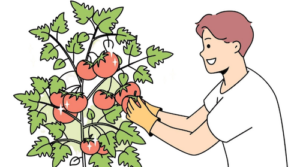
Green, yellow, and red, small as cherries or big enough to cut in half, and enjoy with oil, salt, and basil. For centuries, tomatoes – the scientific name Solanum lycopersicum, which means “wolf fish” – has been the main actor and star on our tables, especially in the summers.
Tomatoes are an incredibly fascinating fruit. In fact, there are at least ten intriguing curiosities about this juicy produce that we should all be aware of. So, let’s delve into the exciting world of science, history, culture, and cuisine to uncover some fascinating facts about tomatoes.
1 – WHERE DOES THE TOMATO COME FROM? It is a berry that originated in Peru and ancient cultures called xitomatl. They were small fruits of a golden color to eat in wedges. Over time, tomatoes would become red due to later grafting.
2 – WHEN DID THEY LAND IN EUROPE? The “pomo d’oro” spread throughout Europe in the sixteenth and seventeenth centuries, starting in Italy, where the physician Pietro Andrea Mattioli (1501-1577) mentioned it for the first time in a scientific treatise.

3 – WHEN WAS THE FIRST SAUCE BORN? The first is the “salsa di Pomodoro, alla spagnuola” in Antonio Latini‘s 1694 recipe book “Lo scalco alla moderna,” on the art of preparing a good sauce with meat and tomatoes.
4 – IS IT A VEGETABLE OR A FRUIT? The tomato is a fruit. So are cucumbers, peppers, squash, peas, and eggplants, since they grow from flowers and have seeds. The tomato was officially deemed a “vegetable” in the U.S., as ruled by the Supreme Court in 1893.
5 – IS IT TRUE THAT TOMATOES ARE HEALTHY? Much so. Because, among other things, it is a source of vitamin C and B vitamins, phosphorus, calcium, and potassium. Scientific studies prove cooked tomatoes are healthier than fresh ones. Cooking for 15 minutes breaks the cell wall and releases lycopene, a valuable antioxidant that fights high cholesterol and heart disease.
6 – IS THERE AN ALLERGY TO TOMATOES? The “tomato allergy” can manifest with tingling in the mouth, hives, and facial swelling, among other symptoms. The problem lies in the fact that certain parts of the tomato are removed during the preparation of the dish, such as the seeds. When this separation is not done, unexpected allergic reactions appear.







